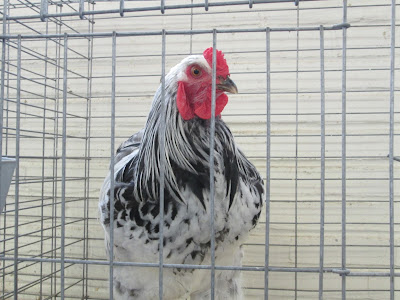 |
| An exhibit at the State Fair in 2014 |
State Agriculture Commissioner Richard A.
Ball on May 31 announced the end of the ban on all live fowl competitions and
exhibits at the Great New York State Fair and at all county fairs in New
York.
The first poultry show at the state Fairgrounds since the ban took place will be at the fairgrounds this coming weekend.
The state Department of Agriculture and Markets issued the ban in June 2015 to prevent the
spread of strains of highly pathogenic avian influenza (HPAI), which killed
millions of birds across the country in 2014-2015 and was confirmed by the U.S.
Department of Agriculture as being the worst outbreak of HPAI in U.S.
history.
“New York took an aggressive approach to
preventing the spread of avian influenza and it paid off,” Ball said. “I am very proud to say that thanks to the cooperation of farmers,
suppliers, distributors, and live bird markets, as well as the hard work of the
Department’s Division of Animal Industry, the outbreak did not affect a single
bird in the state and we look forward to their return at fairs this summer.”
“Lifting this ban was possible due to the
efforts of the poultry industry, here in New York and throughout the U.S., to
stop the spread of HPAI and to improve biosecurity practices. We are
indebted to state and federal animal health officials who contained HPAI in the
Midwest," said state Veterinarian Dr. David Smith.
"While we are
confident the threat has diminished and bird competitions can resume, it’s
important to note that the virus causing HPAI may arise any time, so our
producers must remain vigilant and continue to adhere to the best practices for
preventing the spread of this disease,” Smith said.
The Great New York State Fair is accepting entries for its poultry competitions and exhibits. Exhibitors
can register their animals by going to http://nysfair.ny.gov/competitions/how-to-enter/ this link.
In 2014, about 1,200
poultry and pigeons were brought to the fair for various competitions and
exhibits. The ban has also been lifted for all chartered county fairs and
youth fairs in New York State.
There are 45 county fairs and six youth
shows for the fair season, which runs from June through October.
Oswego County Fair President Carol Sweeney said the poultry will be back at the annual county fair in Sandy Creek, but birds will be checked out and tested by a vet before entering the fairgrounds.
“Our fairgoers and our exhibitors look
forward to these competitions every year and we are excited to bring them back.
They are not only fun, but also an important educational opportunity for
thousands of Fair visitors each year," said Acting Fair Director Troy Waffner.
For more
information, visit the state Department of Agriculture and
Markets website at www.agriculture.ny.gov
















